The Vinyl Ester Market is estimated to be valued at USD 1.5 billion in 2025 and is projected to reach USD 2.7 billion by 2035, registering a compound annual growth rate (CAGR) of 6.1% over the forecast period.
The vinyl ester market is growing steadily, fueled by its extensive application in corrosion-resistant structures and composite materials. Known for its superior mechanical strength, chemical resistance, and thermal stability, vinyl ester resins are widely adopted in industries such as chemical processing, marine, and construction.
The current market landscape is influenced by the increasing use of lightweight and durable materials in manufacturing and infrastructure applications. Rising investments in wastewater treatment and renewable energy sectors have further strengthened demand for corrosion-resistant tanks, pipes, and coatings.
Technological advancements in resin formulation aimed at enhancing curing efficiency and reducing emissions are supporting sustainable production practices. With the global shift toward performance-driven composites, the vinyl ester market is expected to maintain consistent expansion..
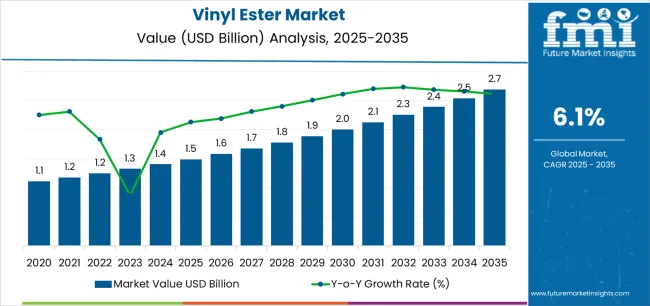
| Metric | Value |
|---|---|
| Vinyl Ester Market Estimated Value in (2025 E) | USD 1.5 billion |
| Vinyl Ester Market Forecast Value in (2035 F) | USD 2.7 billion |
| Forecast CAGR (2025 to 2035) | 6.1% |
The market is segmented by Type and Application and region. By Type, the market is divided into Bisphenol A Diglycidyl Ether (DGEBA), Epoxy Phenol Novolac (EPN), Brominated Fire Retardant, and Others. In terms of Application, the market is classified into Pipes & Tanks, Paints & Coatings, Transportation, Pulp & Paper, and Others. Regionally, the market is classified into North America, Latin America, Western Europe, Eastern Europe, Balkan & Baltic Countries, Russia & Belarus, Central Asia, East Asia, South Asia & Pacific, and the Middle East & Africa.
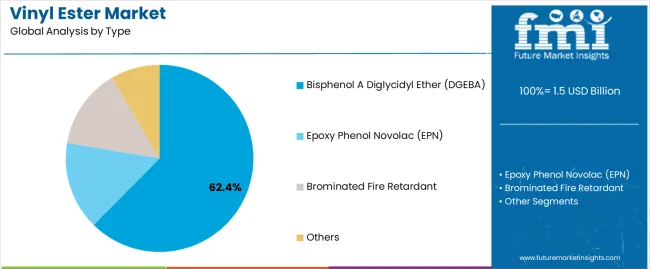
The Bisphenol A Diglycidyl Ether (DGEBA) segment dominates the type category with approximately 62.4% share, owing to its superior balance of strength, chemical resistance, and processability. This resin type is widely utilized in manufacturing corrosion-resistant composites, coatings, and industrial laminates.
Its ability to maintain performance under aggressive chemical exposure makes it the preferred choice for chemical processing and marine applications. The segment also benefits from established production technologies and cost-efficient availability of raw materials.
With rising demand for high-performance materials in industrial and structural applications, the DGEBA segment is expected to continue its leadership throughout the forecast horizon..
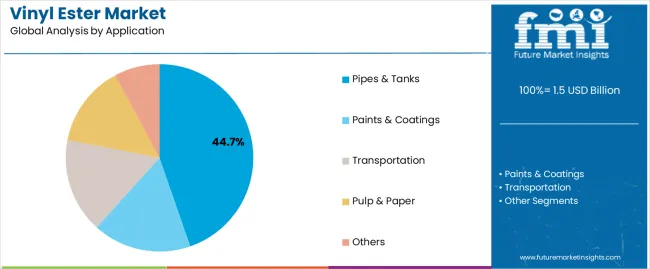
The pipes and tanks segment leads the application category, accounting for approximately 44.7% share, reflecting the material’s extensive use in chemical storage and transport systems. Vinyl ester’s excellent resistance to acids, solvents, and alkalis makes it ideal for fabricating durable tanks and pipelines.
The segment benefits from strong demand across water treatment, petrochemical, and energy sectors where corrosion resistance and long service life are critical. Increased investment in infrastructure for industrial wastewater management and renewable energy storage has reinforced segment growth.
With continued expansion in end-use industries requiring reliable containment solutions, the pipes and tanks segment is projected to maintain dominant market positioning..
| Historical CAGR | 7.6% |
|---|---|
| Forecast CAGR | 6.4% |
The historical Compound Annual Growth Rate (CAGR) of the vinyl ester market stood at a robust 7.6%, indicating strong growth and demand over the past years. However, the forecasted CAGR for the future period is slightly lower at 6.4%, suggesting a modest deceleration in growth compared to the historical trend.
Sustainability Drive
Increasing environmental consciousness and regulations promoting sustainable materials drive the adoption of vinyl ester. Its eco-friendly properties, such as low emissions and recyclability, align with sustainability goals across industries.
Demand from the Construction Sector
Vinyl ester finds extensive use in construction applications, including infrastructure, pipelines, and composite materials. The trend towards infrastructure development, particularly in emerging economies, fuels demand for vinyl ester due to its high strength-to-weight ratio and corrosion resistance.
Growth in Wind Energy
The expansion of wind energy projects worldwide presents a significant opportunity for vinyl ester adoption. As a key component in manufacturing wind turbine blades, vinyl ester's durability and fatigue resistance contribute to the reliability and longevity of wind turbines.
Advancements in Composite Manufacturing
Technological advancements in composite manufacturing processes enhance the performance and versatility of vinyl ester-based composites. Innovations such as automated manufacturing techniques and improved resin formulations expand the application potential of vinyl ester in the aerospace, automotive, and marine sectors.
Expansion in Chemical Processing
Vinyl ester's resistance to corrosive chemicals makes it a preferred material for chemical storage tanks, pipes, and vessels in the chemical processing industry.
With increasing demand for specialty chemicals and petrochemicals, the adoption of vinyl ester-based solutions is expected to grow, driven by its exceptional chemical resistance properties.
This section provides detailed insights into specific categories in the vinyl ester industry. The Bisphenol A Diglycidyl Ether (DGEBA) segment maintains its lead, exhibiting consistent growth over the years.
Similarly, the pipes & tanks segment demonstrates steady growth potential, reflecting sustained demand for vinyl ester in infrastructure applications.
| Top Type | Bisphenol A Diglycidyl Ether (DGEBA) |
|---|---|
| CAGR % 2020 to 2025 | 7.5% |
| CAGR % 2025 to 2035 | 6.2% |
Bisphenol A Diglycidyl Ether (DGEBA) segment is anticipated to rise at a CAGR of 6.2% through 2035.
| Top Application | Pipes & Tanks |
|---|---|
| CAGR % 2020 to 2025 | 7.4% |
| CAGR % 2025 to 2035 | 6.1% |
Pipes & tanks segment to record rise in adoption at a CAGR of 6.1% through 2035.
The section analyzes the vinyl ester market across key countries, including the United States, United Kingdom, China, Japan, and South Korea. The analysis delves into the specific factors driving the demand, adoption, and sales of vinyl esters in these countries.
| Countries | CAGR |
|---|---|
| United States | 6.6% |
| United Kingdom | 7.6% |
| China | 6.8% |
| Japan | 7.8% |
| South Korea | 7.5% |
The vinyl ester industry in the United States is anticipated to rise at a CAGR of 6.6% through 2035.
The vinyl ester industry in the United Kingdom is projected to rise at a CAGR of 7.6% through 2035.
China’s vinyl ester industry is likely to witness expansion at a CAGR of 6.8% through 2035.
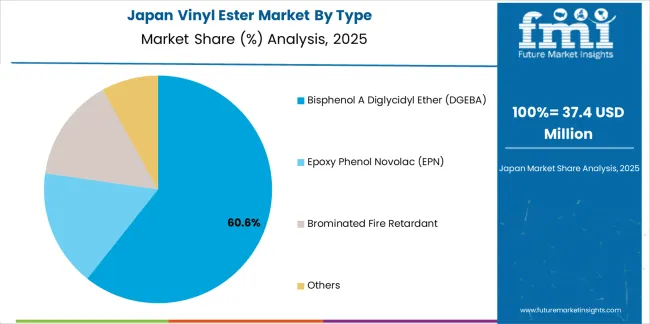
Japan's vinyl ester industry is projected to rise at a CAGR of 7.8% through 2035.
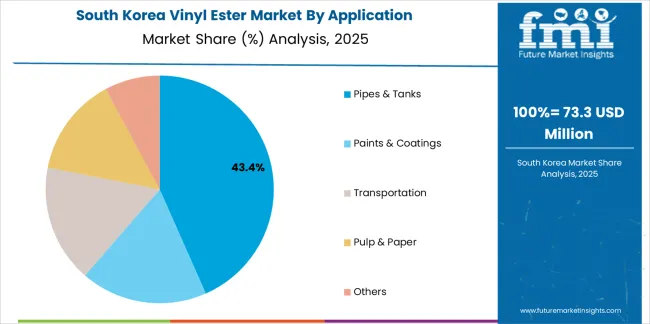
South Korea’s vinyl ester industry is set to expand at a CAGR of 7.5% from 2025 to 2035.
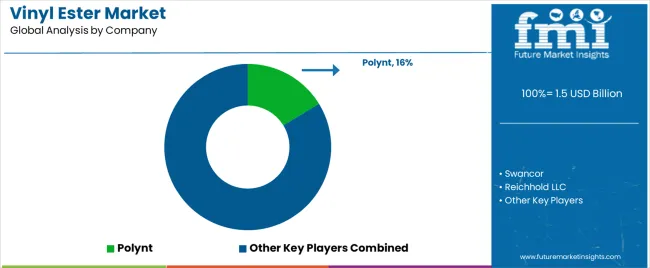
Companies in the vinyl ester sector are strategically positioning themselves to capitalize on emerging opportunities and address evolving customer demands.
The vinyl ester industry is witnessing increased consolidation as companies seek to expand their market presence through mergers, acquisitions, and strategic partnerships. This trend is driven by the need to enhance production capabilities, access new markets, and leverage synergies to gain a competitive edge.
Key players are investing significantly in research and development to introduce innovative vinyl ester formulations with enhanced performance characteristics.
Innovation efforts aim to develop products that offer superior strength, durability, and resistance to corrosion, catering to diverse application requirements across industries such as construction, automotive, and marine.
Companies are forming strategic alliances and collaborations with raw material suppliers, end-users, and research institutions to drive product development and market expansion initiatives.
These partnerships enable knowledge sharing, technology transfer, and access to new markets, fostering growth and innovation within the industry.
With increasing globalization, vinyl ester manufacturers are expanding their geographical footprint to capitalize on emerging markets and diversify their revenue streams.
Sustainability has emerged as a key focus area for vinyl ester manufacturers, driven by regulatory pressures and growing environmental awareness among consumers.
Companies are investing in sustainable production processes, eco-friendly formulations, and recycling initiatives to minimize environmental impact and meet the evolving demands of environmentally conscious customers.
Recent Developments in the Vinyl Ester Industry
The global vinyl ester market is estimated to be valued at USD 1.5 billion in 2025.
The market size for the vinyl ester market is projected to reach USD 2.7 billion by 2035.
The vinyl ester market is expected to grow at a 6.1% CAGR between 2025 and 2035.
The key product types in vinyl ester market are bisphenol a diglycidyl ether (dgeba), epoxy phenol novolac (epn), brominated fire retardant and others.
In terms of application, pipes & tanks segment to command 44.7% share in the vinyl ester market in 2025.






Our Research Products

The "Full Research Suite" delivers actionable market intel, deep dives on markets or technologies, so clients act faster, cut risk, and unlock growth.

The Leaderboard benchmarks and ranks top vendors, classifying them as Established Leaders, Leading Challengers, or Disruptors & Challengers.

Locates where complements amplify value and substitutes erode it, forecasting net impact by horizon

We deliver granular, decision-grade intel: market sizing, 5-year forecasts, pricing, adoption, usage, revenue, and operational KPIs—plus competitor tracking, regulation, and value chains—across 60 countries broadly.

Spot the shifts before they hit your P&L. We track inflection points, adoption curves, pricing moves, and ecosystem plays to show where demand is heading, why it is changing, and what to do next across high-growth markets and disruptive tech

Real-time reads of user behavior. We track shifting priorities, perceptions of today’s and next-gen services, and provider experience, then pace how fast tech moves from trial to adoption, blending buyer, consumer, and channel inputs with social signals (#WhySwitch, #UX).

Partner with our analyst team to build a custom report designed around your business priorities. From analysing market trends to assessing competitors or crafting bespoke datasets, we tailor insights to your needs.
Supplier Intelligence
Discovery & Profiling
Capacity & Footprint
Performance & Risk
Compliance & Governance
Commercial Readiness
Who Supplies Whom
Scorecards & Shortlists
Playbooks & Docs
Category Intelligence
Definition & Scope
Demand & Use Cases
Cost Drivers
Market Structure
Supply Chain Map
Trade & Policy
Operating Norms
Deliverables
Buyer Intelligence
Account Basics
Spend & Scope
Procurement Model
Vendor Requirements
Terms & Policies
Entry Strategy
Pain Points & Triggers
Outputs
Pricing Analysis
Benchmarks
Trends
Should-Cost
Indexation
Landed Cost
Commercial Terms
Deliverables
Brand Analysis
Positioning & Value Prop
Share & Presence
Customer Evidence
Go-to-Market
Digital & Reputation
Compliance & Trust
KPIs & Gaps
Outputs
Full Research Suite comprises of:
Market outlook & trends analysis
Interviews & case studies
Strategic recommendations
Vendor profiles & capabilities analysis
5-year forecasts
8 regions and 60+ country-level data splits
Market segment data splits
12 months of continuous data updates
DELIVERED AS:
PDF EXCEL ONLINE
Vinyl Frame Casement Window Market Size and Share Forecast Outlook 2025 to 2035
Vinyl Sliding Window Market Size and Share Forecast Outlook 2025 to 2035
Vinyl Awning Window Market Size and Share Forecast Outlook 2025 to 2035
Vinyl Windows and Doors Market Size and Share Forecast Outlook 2025 to 2035
Esterquats Market Size and Share Forecast Outlook 2025 to 2035
Vinyl Acetate Homopolymer Market Size and Share Forecast Outlook 2025 to 2035
Vinyl Electrical Tapes Market Size, Share & Forecast 2025 to 2035
Vinyl Flooring Market Growth - Trends & Forecast 2025 to 2035
Esterified Vitamins Market Size, Growth, and Forecast for 2025 to 2035
Esters Market Trends & Outlook 2025 to 2035
Vinyl Extrusion Equipment Market Insights - Growth & Forecast 2025 to 2035
Ester Gums Market Growth – Trends & Forecast 2025 to 2035
Market Positioning & Share in the Vinyl Cyclohexane Industry
Vinyl Films Market
Western Europe Automotive Performance Tuning & Engine Remapping Market Size and Share Forecast Outlook 2025 to 2035
Western Europe Valve Seat Insert Market Size and Share Forecast Outlook 2025 to 2035
Western Europe Automated People Mover Industry Size and Share Forecast Outlook 2025 to 2035
Western Europe Bicycle Component Aftermarket Analysis Size and Share Forecast Outlook 2025 to 2035
Western Blotting Processors Market Trends and Forecast 2025 to 2035
Western Blotting Market is segmented by product, application and end user from 2025 to 2035

Thank you!
You will receive an email from our Business Development Manager. Please be sure to check your SPAM/JUNK folder too.
Chat With
MaRIA